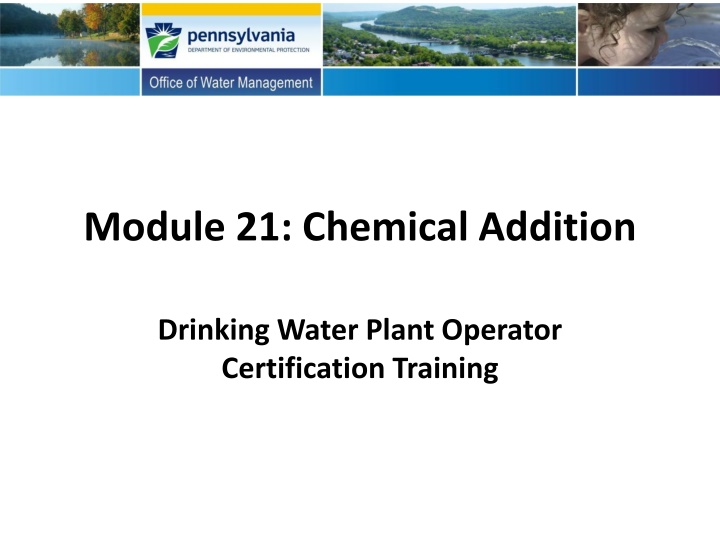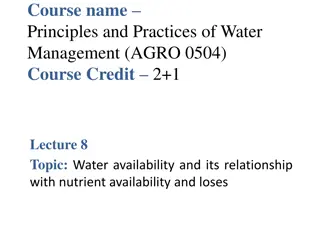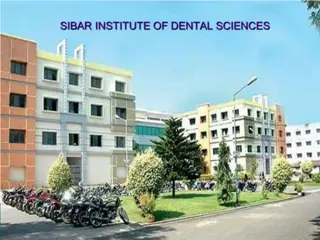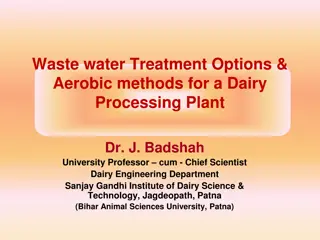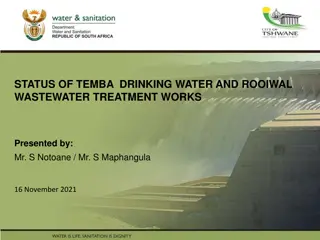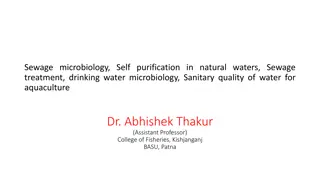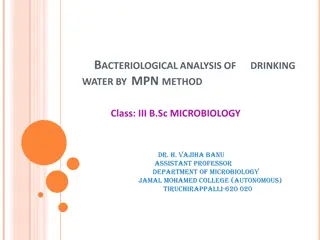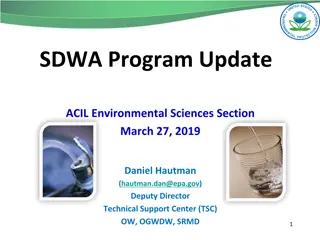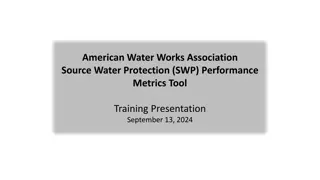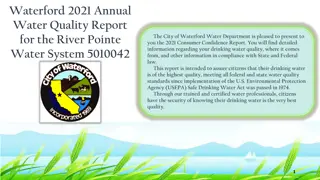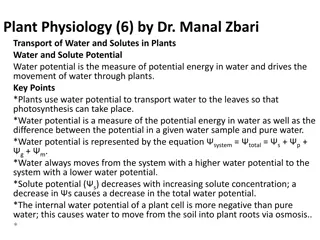Chemical Addition in Drinking Water Treatment Plant Certification Training
Learn about the essential topics of chemical addition in water treatment, including the types of chemicals used, safety measures, dosage calculations, and feed systems. Explore the importance of coagulating chemicals and their role in promoting particle aggregation for effective water treatment. Discover common primary coagulant chemicals and their corresponding pH levels, as well as how different chemicals affect pH levels in water treatment processes.
Download Presentation

Please find below an Image/Link to download the presentation.
The content on the website is provided AS IS for your information and personal use only. It may not be sold, licensed, or shared on other websites without obtaining consent from the author.If you encounter any issues during the download, it is possible that the publisher has removed the file from their server.
You are allowed to download the files provided on this website for personal or commercial use, subject to the condition that they are used lawfully. All files are the property of their respective owners.
The content on the website is provided AS IS for your information and personal use only. It may not be sold, licensed, or shared on other websites without obtaining consent from the author.
E N D
Presentation Transcript
Module 21: Chemical Addition Drinking Water Plant Operator Certification Training
Chemical Addition Topics Unit 1 Chemicals Used in Water Treatment Unit 2 Safety and Handling Unit 3 Chemical Dosage Calculations Unit 4 Chemical Feed Systems 2
Unit 1 Chemicals Used in Water Treatment Learning Objective When given a source water problem, participants will be able to identify on the Chemical Usage Table those chemicals used to address and correct the problem in the treatment of drinking water. 3
Chemical Uses Coagulation Chemicals pH Adjustment Taste and odor control Trace elements and Heavy Metals Corrosion Control and Sequestering Fluoridation Disinfection 4
Coagulating Chemicals The addition of coagulant chemicals promotes the destabilization of the smaller, non- settleable particles and colloidal particles resulting in the aggregation of these particles into larger, more settleable floc. Types of coagulating chemicals? Ferric Chloride Aluminum Chloride 5
Types of Coagulant Chemicals Coagulants Coagulant Aids Primary Coagulants 6
Common primary coagulant chemicals and their corresponding Common Primary Coagulant Chemicals pHs Type Chemical pH Dry Alum (Aluminum Sulfate) Liquid Alum (Aluminum Sulfate) 3.3-3.6 Aluminum Salts 2.1 Poly Aluminum Chloride 1.8 less than 2 Ferric Chloride Iron Salts Ferric Sulfate 1 7
pH 8
If you add The pH will be: Raised KOH Potassium hydroxide Nitric Acid Calcium Hydroxide Hydrated Lime HNO3 Ca(OH)2 Lowered Raised Calcium Hydroxide Slaked Lime Ca(OH)3 Raised Sulfuric Acid Sodium Hydroxide AKA: Caustic Soda H2SO4 NaOH Lowered Raised 9 Soda Ash Na2CO3 Raised
Practically every phase of water treatment is pH dependent. Coagulation Efficiency Iron and Manganese Removal pH Disinfection Efficiency Corrosion Control Treatment Disinfection By-product Creation 10
Alkalinity Alkalinity is a measure of the capacity of water or any solution to neutralize or buffer acids. This measure of acid-neutralizing capacity is important in figuring out how buffered the water is against sudden changes in pH. Alkalinity should not be confused with pH. 11
Chemical Impacts on Alkalinity 1 part alum uses 0.5 parts alkalinity for proper coagulation 1 part ferric chloride will consume 0.92 parts alkalinity for proper coagulation Sodium bicarbonate (Bicarbonate Soda) will make water more alkaline. It can be used when you only want to increase the alkalinity. pH adjustment chemicals may also increase alkalinity. Therefore, alkalinity may be increase by the addition of lime, caustic soda or soda ash. 12
Taste and Odor Taste and odor in drinking water are among the most common and difficult problems that confront waterworks operators. Various chemicals are added to remove tastes and odors. There are two general methods for controlling tastes and odors. Removal of the causes of the tastes and odors Destruction of taste and odor causing compounds 13
Removal of Trace Elements and Heavy Metals In small quantities, certain heavy metals are nutritionally essential for a healthy life, but large amounts of any of them may cause acute or chronic toxicity (poisoning). There are three processes by which these removals are accomplished: Oxidation Improved Coagulation/Flocculation/Sedimentation 14
Corrosion Control and Sequestration Corrosive water is characterized by pH and alkalinity values that are somewhat lower than they should be for the water to be considered stable . Chemical Treatment of Corrosive Water: Stabilizing the water. The use of corrosion inhibitors. 15
Fluoridation Fluoride is added to the drinking water to improve the development of teeth and bones in young children! Most commonly added fluoridation chemicals: sodium fluoride sodium silicofluoride hydrofluosilicic acid Please note: any fluoride chemical is nasty. Please wear the appropriate PPE like a face shield, rubber apron, and rubber 16
Disinfection Disinfection kills or inactivates disease- causing organisms in a water supply. There are two kinds of disinfection: Primary disinfection achieves the desired level of microorganism kill or inactivation. Secondary disinfection maintains a disinfectant residual in the finished water that prevents the regrowth of microorganisms. 17
Chemical Usage Table Key Information on various chemicals for your reference 18
Unit 1 Exercise 1. Coagulation 2. Coagulant aids 3. pH 4. Alkalinity 5. Calcium and Magnesium 6. Sequestering agents 7. Primary disinfection 8. Secondary disinfection 19
Question 9 The pH will be raised or lowered Raised If you add: 1.NaOH 1.Aluminum Sulfate Lowered 1.Ca (OH)2 1.Sulfuric Acid 1.H2SiF6 1.Ferric Chloride 1.Na2CO3 Raised Lowered Lowered Lowered Raised 20
Unit Quiz Questions 10/11 2. Name several chemicals which might be added during the coagulation process. 1. List the chemicals you might add to control odor. Include the chemical name and best feeding form for each. Activated Carbon - Dry to form slurry Ozone Gas Pot Permanganate - Dry to form solution Sodium Chlorite - Dry or solution Chlorine Gas Sodium Hypochlorite Solution Aluminum Sulfate - Coagulant Ferric Chloride - Coagulant Ferric Sulfate - Coagulant Poly Aluminum Chloride -Coagulant Calcium Hydroxide-pH Adjustment Calcium Oxide - Sodium Bicarbonate - pH Adjustment Sodium Carbonate - pH Adjustment pH Adjustment 21
Unit 2 Key Points Page 1-16 in the workbook 22
Unit 2 Safety and Handling Learning Objectives When given a Material Safety Data Sheet and specific chemical names, identify specific information related to chemical characteristics and other information provided . List the five components of Chemical Handling Equipment. 23
Parts of the SDS 16 required sections Now available electronically (pull it up on your phone!) 24
Five Components of Chemical Handling Equipment 1. Selection of Equipment follow the SDS 2. Labels and Warning Signs 3. Breathing Protection 4. Protective Clothing 5. Protective Equipment. 25
Emergency Response Planning An emergency response plan (ERP) must be developed to help a system protect public health, limit damage to the system and the surrounding area, and help a system return to normal as soon as possible. Employees who are prepared know what actions must be taken in the event of an emergency. A good ERP includes: Contact information Assessment of Available Resources Corrective Actions For Probable Emergency 26
Unit 2 Key Points The single most important resource for finding information about a chemical is the Material Safety Data Sheet (MSDS). When using chemicals, protections are necessary. These protections include labels, signs, and safe chemical handling equipment. Not all chemicals require the same protections. A good Emergency Response Plan contains contact information, an assessment of available resources to be used in the event of an emergency in 27
Unit 3 Chemical Dosage Calculations Learning Objective When given the formula and required data, calculate chemical dosages for each of the following: Dry Chemicals, Liquid Chemicals, and Gaseous Chemicals . 28
Feed Systems treatment system at rates necessary for optimal performance. When designing a chemical feed system consider: Feed system need to deliver chemicals into the Building redundancy into the system so if there is a failure or malfunction in the primary system, a secondary system can be used. Checking the feed pump dosage range. Feed pumps should be sized so that chemical dosages can be changed to meet varying conditions. Evaluating the condition of the chemical feed system regularly. Preventative maintenance is critical for 29
1. Chemical Storage 2. Suction Assembly 1. Foot Valve 2. Suction Strainer 3. Calibration Chamber 4. Four-Function Valve 1. Anti-Siphon Valve 2. Back Pressure Relief Valve 3. Pressure Relief Valve 4. Priming Function 5. Pulsation Dampener 6. Injector Assembly 7. Liquid Feed Pump Flow Chemical Feed System 30
Mechanical Diaphragm Metering Pump Pump pulling chemical from the storage container: Valve Closed Discharge Check Valve (Outlet) Plunger moves left Diaphragm Suction Check Valve (Inlet) Valve Open 31
Mechanical Diaphragm Metering Pump Chemical is pushed in to the system. Discharge Check Valve (Outlet) Valve Open Plunger moves right Diaphragm Suction Check Valve (Inlet) 32 Valve Closed
Adjusting Chemical Feed Pump Dosage The output of the pump is controlled by the length of the plunger stroke and the number of repetitions of the stroke (the speed and the stroke). Pumps may be controlled manually or by a rate of flow meter (flow pacing). 33
Liquid Chemical Feed System Operation and Maintenance Observe all operating components daily. Maintain a regular schedule of maintenance on all equipment as per the manufacturer s recommendations Chemical metering pumps should be calibrated on a regular basis or when the operator suspects a problem with the pump (pump calibration demonstration to follow). Any leak throughout the system will cause a reduction in the amount of chemical solution pumped. All leaks must be repaired as soon as they are discovered. If the pump looks to be operating, but the chemical feed is less than expected, suspect a ruptured diaphragm. The suction assembly on a chemical metering pump should be inspected and cleaned on a regular basis as per the manufacturer s recommendations. 34
Dry Chemical Feed Systems Used to feed chemicals like: Lime Fluoride Carbon Potassium permanganate A dry feeder measures dry chemical and mixes it with water in a solution tank. The resulting solution is either pumped into the main water flow of the system or fed in using an ejector. An ejector system uses the Venturi effect to create a vacuum and moves the solution into the main water flow. 35
Volumetric Dry Feeders Chemical is usually stored in a silo above the unit and each time the system needs to make a new batch of solution a feed mechanism (rolls or screws) to deliver exactly the same volume of dry chemical to the dissolving tank with each complete revolution. 36
Gravimetric Dry Feeders This is a belt-type feeder that delivers a certain weight of material with each revolution of the conveyor belt. 37
Dry Chemical Feed System Operation and Maintenance 1. Observe operating components daily. 2. Follow manufacturer s recommendations when performing maintenance. 3. These units are feeding fine powdery chemicals therefore cleaning and inspection of all moving parts should be conducted routinely. 4. After all preventative maintenance has been completed, proper calibration should be completed. 38
Detention Time Detention time indicates the amount of time a give flow of water is retained by a unit process. It is calculated as the tank volume divided by the flow rate: Detention Time Equation Theoretical Detention Time (minutes) = Volume of Tank (gallons) Influent Flow (gpm) Time units match = minutes Volume units match = gallons 39
There are two basic ways to consider detention time: Detention time is the length of time required for a given flow rate to pass through a tank. Detention time may also be considered as the length of time required to fill a tank at a given flow rate. Flow Flow Flow 40
Example 3.1 Detention Time Calculation A sedimentation tank holds 50,000 gallons and the flow into the plant is 500 gpm. What is the detention time in minutes? Detention Time (time) = Volume = 50,000 gallons Flow 500 gpm minutes = 100 41
Example 3.2 Detention Time Calculation A tank is 20 feet by 35 feet by 10 feet. It receives a flow of 650 gpm. What is the detention time in minutes? 1. First must find volume (in gallons) then plug into Detention Time formula. Volume = L x W x H 20 feet x 35 feet x 10 feet = 7,000 ft3 2. Convert to gallons from ft3 gallons = 7,000 ft3 x 7.48 gallons = 52,360 gallons 42
Example 3.3 Detention Time Calculation A flash mix chamber has a volume of 450 gallons. The plant flow is set at 5 MGD. What is the detention time of the flash chamber is seconds? (Assume the flow is steady and continuous). First, convert the flow rate from MGD to gps (5 MGD = 5,000,000 gpd) 5,000,000 gal x day x min = 58 gallon day 1440 min Plug into: Detention Time (time) = Volume = 60 seconds second 43
Example 3.4 Detention Time Calculation A water treatment plant treats a flow of 1.5 MGD. It has 2 sedimentation basins, each 20 feet wide by 60 feet long, with an effective water depth of 12 feet. Calculate the Theoretical Sedimentation Detention Time with both basins in service (in hours). Volume of something rectangular: V = L x W x D 60 ft x 20 ft x 12 ft = 14,400 ft3 You have two tanks to take into account 14,400 ft3 x 2 28,800 ft3 You have to convert to gallons = 28,800 ft3 x 7.48 = 215,424 gallons 44 Convert from MGD to gpd = 1.5 x 1,000,000 = 1,500,000 gpd
Precipitation: The chemical conversion of soluble substances (including metals) into insoluble particles. 45
Purpose of Coagulation particles to become chemically destabilized and clump together to form floc. Coagulating chemicals are added to water causing Coagulation is the destabilization of colloidal particles brought about by the addition of a chemical reagent known as a coagulant. 46
How do we know if our coagulant dosage is correct? Jar Testing is a laboratory procedure that simulates coagulation, flocculation, and precipitation results with differing chemical dosages. 47
Jar Tests Evaluation Evaluate test results in each container: Visual evaluation or measure turbidity with turbidimeter. Rate of floc formation Type of floc Floc settling rate 48
Dry Chemical Solution Day Tanks A day tank is used to store a limited supply of diluted chemical solution to be fed into the treatment system. The solution in a day tank can be diluted to a specific concentration (strength). The solution consists of two parts: 1. Solute: The dry product that you are adding or the amount of dry product in a concentrated solution. 2. Solvent: The liquid which is dissolving the solute. Solute Solvent 49
Example 3.5 Example Dry Feed Solution Tank Mixing How many pounds of dry chemical must be added to a 50 gallons day tank to produce a 0.5% solution? Hint: Every gallon of water weighs 8.34 pounds. Pounds = 8.34 pounds x 50 gallons x 0.005 = gallon 50
